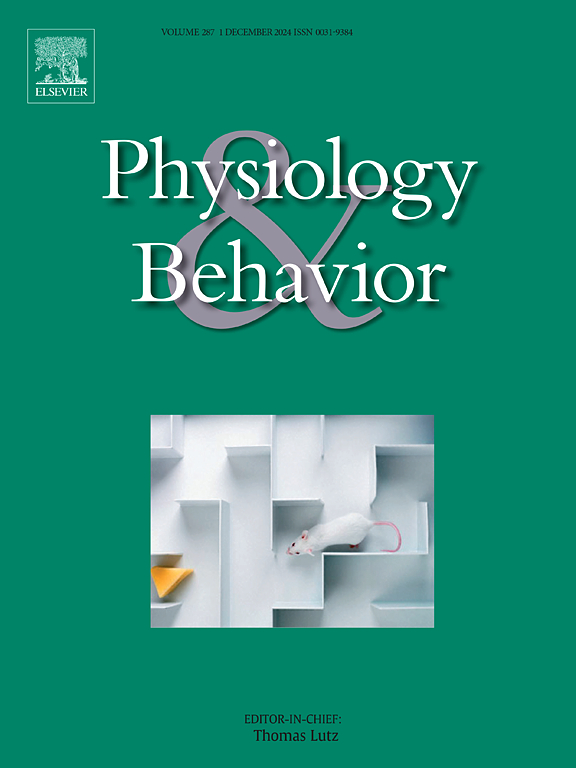猴子和人类对脂肪、糖和口腔感官食物品质的偏好。
IF 2.4
3区 医学
Q2 BEHAVIORAL SCIENCES
引用次数: 0
摘要
在人类和其他灵长类动物中,食物摄入取决于对营养物质和口腔感觉食物质量的复杂、个性化偏好,这些偏好指导着决策和饮食行为。这种灵长类动物典型食物偏好的神经和行为机制仍然知之甚少,尽管它们对人类健康和肥胖药物治疗的目标很重要。在这里,我们回顾了一系列实验,这些实验研究了食物的生物学关键特性——它们的营养成分(糖、脂肪、蛋白质)和口腔感官质量(粘度、口腔滑动摩擦)——如何影响猴子和人类的食物偏好。在经济营养选择范式中,猕猴灵活地交易营养和口腔感官食物质量,反对不同的食物量,与主观价值的分配一致。将客观营养成分与主观价值联系起来的营养价值函数准确地模拟了这些偏好,预测了不同情况下的选择,并解释了个体差异。猴子对营养物质的偏好导致它们的日常营养平衡偏离了饮食参考点,就像人类在接触高热量食物时的次优饮食模式一样。为了研究营养价值背后的感官基础,我们开发了新的工程工具,使用新鲜的猪舌来量化口腔表面的食物质地。口腔质地(即口感)参数,包括粘度和滑动摩擦,被证明可以调节猴子对高脂肪食物的偏好。当被移植到人类实验对象身上时,这种方法揭示了眼眶前额皮质(OFC)中偏爱高脂肪食物的神经机制——这是大脑的一个关键奖励系统。重要的是,人类OFC对个体受试者口腔滑动摩擦的反应——在MRI扫描仪中测量——预测了随后在一个自然的、逼真的饮食测试中摄入的脂肪。这些发现表明,灵长类动物的营养奖励模式为研究人类典型的食物奖励和食物选择的行为和神经机制提供了一种很有前途的方法,可以促进对人类饮食行为、暴饮暴食和肥胖的理解。本文章由计算机程序翻译,如有差异,请以英文原文为准。
Preferences for fat, sugar, and oral-sensory food qualities in monkeys and humans
In humans and other primates, food intake depends on sophisticated, individualized preferences for nutrients and oral-sensory food qualities that guide decision-making and eating behavior. The neural and behavioral mechanisms for such primate-typical food preferences remain poorly understood, despite their importance for human health and their targeting by pharmacological obesity treatments. Here, we review a series of experiments that investigated how the biologically critical properties of foods—their nutrients (sugar, fat, protein) and oral-sensory qualities (viscosity, oral sliding friction)—influence food preferences in monkeys and humans. In an economic nutrient-choice paradigm, macaques flexibly trade nutrients and oral-sensory food qualities against varying food amounts, consistent with the assignment of subjective values. Nutrient-value functions that link objective nutrient content to subjective values accurately model these preferences, predict choices across contexts, and explain individual differences. The monkeys’ aggregated choice patterns resulting from their nutrient preferences lead to daily nutrient balances that deviate from dietary reference points, resembling suboptimal human eating patterns when exposed to high-calorie foods. To investigate the sensory basis underlying nutrient values, we developed novel engineering tools that quantify food textures on oral surfaces, using fresh pig tongues. Oral-texture (i.e., mouthfeel) parameters, including viscosity and sliding friction, were shown to mediate monkeys' preferences for high-fat foods. When translated to human subjects, this approach revealed a neural mechanism for preferring high-fat foods from oral texture in the orbitofrontal cortex (OFC)—a key reward system of the brain. Importantly, human OFC responses to oral sliding friction in individual subjects—measured in the MRI scanner—predicted subsequent fat intake in a naturalistic, life-like eating test. These findings suggest that a primate nutrient-reward paradigm offers a promising approach for investigating the behavioral and neural mechanisms for human-typical food reward and food choice, to advance understanding of human eating behavior, overeating, and obesity.
求助全文
通过发布文献求助,成功后即可免费获取论文全文。
去求助
来源期刊

Physiology & Behavior
医学-行为科学
CiteScore
5.70
自引率
3.40%
发文量
274
审稿时长
47 days
期刊介绍:
Physiology & Behavior is aimed at the causal physiological mechanisms of behavior and its modulation by environmental factors. The journal invites original reports in the broad area of behavioral and cognitive neuroscience, in which at least one variable is physiological and the primary emphasis and theoretical context are behavioral. The range of subjects includes behavioral neuroendocrinology, psychoneuroimmunology, learning and memory, ingestion, social behavior, and studies related to the mechanisms of psychopathology. Contemporary reviews and theoretical articles are welcomed and the Editors invite such proposals from interested authors.
 求助内容:
求助内容: 应助结果提醒方式:
应助结果提醒方式:


